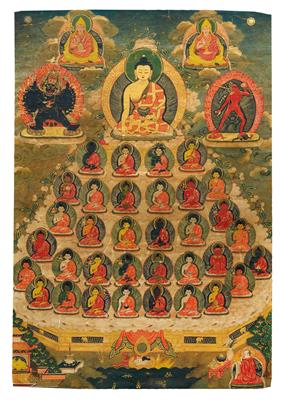Thangka der 35 Bekenntnisbuddhas, Tibet 18th /19th cent.

Gelupga tradition, mixed media and gilt painting on cloth, image size 41.5 x 28.5 cm, full size 67 x 42 (46.3) cm, (Hr)
We are grateful to Uwe Niebuhr MA for his assistance with the cataloguing of this work. This thangka depicts the 35 Confessional Buddhas (Tibetan = ltung bshags bde gshegs sum cu so lnga). The text of the Triskhandhadharmasutra (Tib. phung po gsum pai mdo) is amongst the best-known Buddhist Mahayana texts, which are mainly used by monks and nuns for the confession of downfalls, such as transgressions against the monastery or convent rules or the Bodhisattva vow. By means of regular or daily recitation, the meditating person can free themselves of their misdemeanours, by calling on the Buddhas one after the other. There are several iconographical programmes in Tibetan art for the depiction of the 35 Confessional Buddhas. According to the scholar, Nagarjuna, the Buddhas are depicted with varying gestures (Skt. mudra) and attributes in their hands, to aid individual identification. Often only shown as attendant figures in paintings, the 35 Confessional Buddhas became a key theme of Tibetan scroll painting as early as the 14th century. In the centre, the Buddha Sakyamuni is depicted in the patchwork garment of a monk with a begging bowl and his hand in the earth-touching gesture. He sits on a white crescent moon above a yellow throne with a lotus. He forms the apex of a pyramid made up of 34 smaller Buddha figures arrayed in five rows on cloudy lotus leaves, who in their turn rest on a large yellow throne decorated with elephant motifs encircled by green twigs. Buddha Sakyamuni and the smaller Buddha figures are shown frontally with mandorlas and nimbuses, alternating green and blue in colour. They vary one from the other in the colours of their bodies, varying from white, yellow, red, green, blue to brown. Except for two figures, they all have one or more attributes. (...)
Esperta: Regina Herbst
 Regina Herbst
Regina Herbst
+43-1-515 60-356
regina.herbst@dorotheum.at
04.04.2018 - 15:00
- Prezzo realizzato: **
-
EUR 3.500,-
- Prezzo di partenza:
-
EUR 1.800,-
Thangka der 35 Bekenntnisbuddhas, Tibet 18th /19th cent.
Gelupga tradition, mixed media and gilt painting on cloth, image size 41.5 x 28.5 cm, full size 67 x 42 (46.3) cm, (Hr)
We are grateful to Uwe Niebuhr MA for his assistance with the cataloguing of this work. This thangka depicts the 35 Confessional Buddhas (Tibetan = ltung bshags bde gshegs sum cu so lnga). The text of the Triskhandhadharmasutra (Tib. phung po gsum pai mdo) is amongst the best-known Buddhist Mahayana texts, which are mainly used by monks and nuns for the confession of downfalls, such as transgressions against the monastery or convent rules or the Bodhisattva vow. By means of regular or daily recitation, the meditating person can free themselves of their misdemeanours, by calling on the Buddhas one after the other. There are several iconographical programmes in Tibetan art for the depiction of the 35 Confessional Buddhas. According to the scholar, Nagarjuna, the Buddhas are depicted with varying gestures (Skt. mudra) and attributes in their hands, to aid individual identification. Often only shown as attendant figures in paintings, the 35 Confessional Buddhas became a key theme of Tibetan scroll painting as early as the 14th century. In the centre, the Buddha Sakyamuni is depicted in the patchwork garment of a monk with a begging bowl and his hand in the earth-touching gesture. He sits on a white crescent moon above a yellow throne with a lotus. He forms the apex of a pyramid made up of 34 smaller Buddha figures arrayed in five rows on cloudy lotus leaves, who in their turn rest on a large yellow throne decorated with elephant motifs encircled by green twigs. Buddha Sakyamuni and the smaller Buddha figures are shown frontally with mandorlas and nimbuses, alternating green and blue in colour. They vary one from the other in the colours of their bodies, varying from white, yellow, red, green, blue to brown. Except for two figures, they all have one or more attributes. (...)
Esperta: Regina Herbst
 Regina Herbst
Regina Herbst
+43-1-515 60-356
regina.herbst@dorotheum.at
|
Hotline dell'acquirente
lun-ven: 10.00 - 17.00
kundendienst@dorotheum.at +43 1 515 60 200 |
| Asta: | Orologi, arte asiatica, vintage, metalli lavorati, fayence, arte popolare, sculture |
| Tipo d'asta: | Asta in sala |
| Data: | 04.04.2018 - 15:00 |
| Luogo dell'asta: | Wien | Palais Dorotheum |
| Esposizione: | 28.03. - 04.04.2018 |
** Prezzo d’acquisto comprensivo dei diritti d’asta acquirente e IVA
Non è più possibile effettuare un ordine di acquisto su Internet. L'asta è in preparazione o è già stata eseguita.
